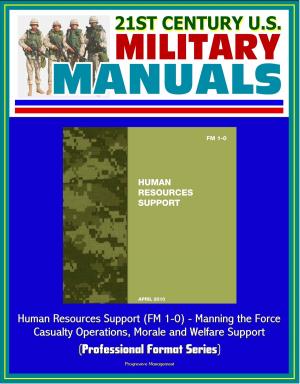Operations of - and Challenges to - the Army Medical Department (AMEDD) During the U.S. - Mexican War, 1846-1848: Field Operations of Major Generals Winfield Scott and Zachary Taylor
Nonfiction, History, Americas, Mexico, Military, United States| Author: | Progressive Management | ISBN: | 9781370125562 |
| Publisher: | Progressive Management | Publication: | January 28, 2017 |
| Imprint: | Smashwords Edition | Language: | English |
| Author: | Progressive Management |
| ISBN: | 9781370125562 |
| Publisher: | Progressive Management |
| Publication: | January 28, 2017 |
| Imprint: | Smashwords Edition |
| Language: | English |
This excellent report has been professionally converted for accurate flowing-text e-book format reproduction. Throughout its history, the Army Medical Department (AMEDD) has faced unique challenges not shared by other organizations within the Army. The origins of many of today's organizational structures and operations are rooted in experiences in the mid-19th century, specifically the US-Mexican and American Civil Wars. The purpose of this study is to explore the organizational structure of the AMEDD before, during, and after the US-Mexican War and the operational challenges faced with supply, battlefield medicine, and patient care during the conflict, and post-war after care. This study draws on a variety of sources including memoirs, personal journals, journal articles, field reports, official correspondences, congressional papers, army regulations, and compiled histories of the Army Medial Department. The field operations of Major Generals Winfield Scott and Zachary Taylor are used as case studies. This study will ultimately show that while the AMEDD made great strides towards improving its position within the regular army and improving its operational procedures, the AMEDD missed many opportunities to improve before the American Civil War.
On 13 May 1846, President James Knox Polk issued a proclamation officially entering into a war with Mexico, although military operations on the Rio Grande had already commenced. At the time of the U.S.-Mexican War, the Army Medical Department (AMEDD) was still in its infancy. Despite the necessity for medical providers in both the American Revolution and the War of 1812, a permanent medical department was not established until an act of Congress passed on 14 April 1818. From 1836 to 1861, Dr. Thomas Lawson served as the second Surgeon General of the army. The Second Seminole War in Florida was his preeminent concern during his first decade, and the war with Mexico occupied only two years of his twenty-five year tenure. However, the operational and organizational obstacles faced remained his primary concerns until the end of his term on the eve of the American Civil War as he struggled to move the AMEDD from a preprofessional to professional organization. This paper seeks to explore the organizational structure of the AMEDD prior to, during, and after the war; its place within the larger army; and operational challenges in the fields of supply, battlefield medicine, personnel, and after-care of soldiers. Before the outbreak of the conflict, the AMEDD was geared primarily towards peacetime and garrison operations— policies and procedures for battlefield medical care was not yet established. As an organization, it had difficulty transitioning to wartime operations and still largely operated as if it were in garrison. The military campaigns of Generals Taylor and Scott serve as case studies for the AMEDD's handling of its wartime responsibilities.
From the founding of the United States Army, there has always been a medical presence. Physicians and doctors have served units in garrison and in the field on short-term expeditions and during the Revolutionary War and War of 1812. However, except in times of emergency or crisis and before the creation of AMEDD, there was no consistent leader or a specific medical department. The first man to lead the Army's medical personnel was Benjamin Church.
This excellent report has been professionally converted for accurate flowing-text e-book format reproduction. Throughout its history, the Army Medical Department (AMEDD) has faced unique challenges not shared by other organizations within the Army. The origins of many of today's organizational structures and operations are rooted in experiences in the mid-19th century, specifically the US-Mexican and American Civil Wars. The purpose of this study is to explore the organizational structure of the AMEDD before, during, and after the US-Mexican War and the operational challenges faced with supply, battlefield medicine, and patient care during the conflict, and post-war after care. This study draws on a variety of sources including memoirs, personal journals, journal articles, field reports, official correspondences, congressional papers, army regulations, and compiled histories of the Army Medial Department. The field operations of Major Generals Winfield Scott and Zachary Taylor are used as case studies. This study will ultimately show that while the AMEDD made great strides towards improving its position within the regular army and improving its operational procedures, the AMEDD missed many opportunities to improve before the American Civil War.
On 13 May 1846, President James Knox Polk issued a proclamation officially entering into a war with Mexico, although military operations on the Rio Grande had already commenced. At the time of the U.S.-Mexican War, the Army Medical Department (AMEDD) was still in its infancy. Despite the necessity for medical providers in both the American Revolution and the War of 1812, a permanent medical department was not established until an act of Congress passed on 14 April 1818. From 1836 to 1861, Dr. Thomas Lawson served as the second Surgeon General of the army. The Second Seminole War in Florida was his preeminent concern during his first decade, and the war with Mexico occupied only two years of his twenty-five year tenure. However, the operational and organizational obstacles faced remained his primary concerns until the end of his term on the eve of the American Civil War as he struggled to move the AMEDD from a preprofessional to professional organization. This paper seeks to explore the organizational structure of the AMEDD prior to, during, and after the war; its place within the larger army; and operational challenges in the fields of supply, battlefield medicine, personnel, and after-care of soldiers. Before the outbreak of the conflict, the AMEDD was geared primarily towards peacetime and garrison operations— policies and procedures for battlefield medical care was not yet established. As an organization, it had difficulty transitioning to wartime operations and still largely operated as if it were in garrison. The military campaigns of Generals Taylor and Scott serve as case studies for the AMEDD's handling of its wartime responsibilities.
From the founding of the United States Army, there has always been a medical presence. Physicians and doctors have served units in garrison and in the field on short-term expeditions and during the Revolutionary War and War of 1812. However, except in times of emergency or crisis and before the creation of AMEDD, there was no consistent leader or a specific medical department. The first man to lead the Army's medical personnel was Benjamin Church.















